In this week’s series of stretches, we look at some key stretches for the forelimbs and neck of the horse, and some shoulder stretches for yourself.
Let’s start with the stretches for the horse. The forelimb stretches below are similar to the hindlimb stretches shown in last weeks programme, in that we are showing protraction and retraction and they are ‘passive’. The neck stretches are ‘active’ stretches. This means that there is no assistance from an external force in terms of actually performing the stretch for the horse. The horse is actively moving into the stretch independently (although usually with the helpful aid of a carrot!) Active stretching is very useful as a rehabilitation tool. I find that if you are going to do both passive and active stretches, do the passive ones first else you may find yourself being vigourously searched for the treat making the stretches a little less effective!
Again, I cannot stress enough that the ground rules of stretching must be adhered to prior to starting. Warm up, Stretch only to the point of tension, Stretch the opposing muscle groups, Stretch gently and slowly. With carrot stretches, the horse may be slightly more enthusiastic than usual in the quest to get to the carrot. In order to perform these in controlled manner, place the carrot close to the horses muzzle to encourage a smooth stretch (rather than the horse lunging for the treat.) Chopping the carrots into batons will ensure that the horse will not be consuming too many! Remember, stretching on a surface (arena, rubber matting, grass) is safer than stretching on a concrete yard. Consider any underlying health issues your horse may have (eg arthritic changes, recent diagnoses / surgeries), which may limit / exclude stretching certain areas. Each horse is individual and stretches must be treated as so. If in any doubt about any of the stretches, speak to your Vet or therapist.
Forelimb Protraction
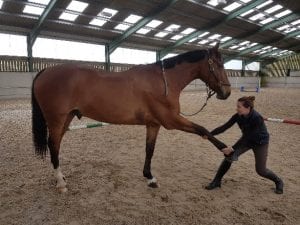
Technique:
Face towards the back of the horse and pick up the front foot (as if you were picking the hoof). Gently bring the upper part of the leg forward whilst supporting the underside of the knee, and wait for the horse to balance and relax into your support. Gently bring forward towards you to stretch the back of the limb and shoulder. If the horse has joint problems stop here. If not, keep one hand under the knee and slide one hand down to the back of the fetlock and stretch the whole limb. Hold the stretch for 5-15 seconds. Replace to the normal standing position gently
Muscles being stretched:
Triceps, latissimus dorsai, flexor muscles
Additional information for performing this stretch correctly:
Support the leg, so the horse feels secure and relaxes the leg into the stretch, rather than forcing it. Let him find is own way. Do not over stretch. Start small
Forelimb Retraction
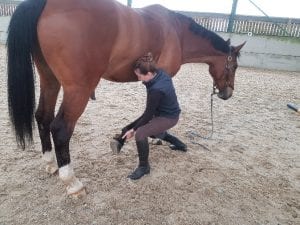
Technique:
Face towards the back of the horse and pick up the front foot (as if you were picking the hoof). Hold the leg at the knee and the fetlock in a flexed position. Allow the horse to balance and relax. Stabilise yourself and in a slightly lunged position, using your thigh if needed, gently encourage the leg backwards, all the while supporting the knee and fetlock. Hold the stretch for 5-15 seconds. Replace to the normal standing position gently
Muscles being stretched:
Femoral biceps, deltoid, extensor muscles, descending pectoral, lower part of the brachiocephalic muscle.
Additional information for performing this stretch correctly:
Support the leg, so the horse feels secure and relaxes the leg into the stretch, rather than forcing it. Let him find is own way. Do not over stretch. Start small
Mid neck stretch
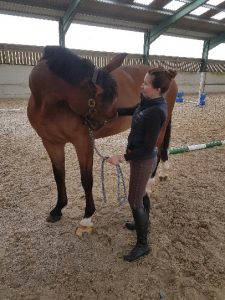
Technique:
Take a carrot and place near the horses mouth. Slowly take the carrot round to the horses elbow.
Muscles being stretched:
Splenius (mid section), cervical ventral serrated
Additional information for performing this stretch correctly:
Perform this stretch slowly in a controlled fashion so the horse is not lunging for the treat! Try to keep the horses nose as straight as possible and do not take the stretch too far back (else you will be influencing different muscles.)
Lateral neck stretch (for the base of the neck)
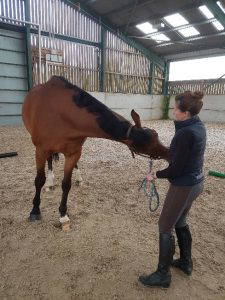
Technique:
Take a carrot and place near the horses mouth. Slowly take the carrot forward and guide head out to the side.
Muscles being stretched:
Cervical ventral serrated, subclavian, brachiocephalic
Additional information for performing this stretch correctly:
Perform this stretch slowly in a controlled fashion so the horse is not lunging for the treat! Try to keep the horses nose as straight as possible.
Forward extension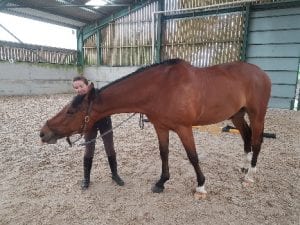
Technique:
Take a carrot and place near the horses mouth. Slowly take the carrot straight out in front, at the level of the horses sternum.
Muscles being stretched:
Muscles throughout the neck, effect on abdominals as the horse reaches forward
Additional information for performing this stretch correctly:
Perform this stretch slowly in a controlled fashion so the horse is not lunging for the treat! Try to keep the horses nose as straight as possible.
And now some stretches for you!
Forward flexion neck stretch
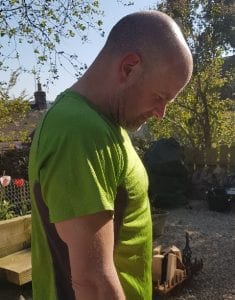
Technique:
Standing, place your chin forward onto your chest. Relax your shoulders down.
Muscles being stretched:
Muscles at the back of the neck and shoulder, including splenius, levator scapulae and spinalis. Muscles of the upper back including trapezius and rhomboids.
Additional information for performing this stretch correctly:
Do not force this stretch. Keep your shoulder relaxed, not hunched and allow the weight of your head to carry the stretch. Hold for a minimum of 20 seconds, maximum of 45
Diagonal flexion neck stretch
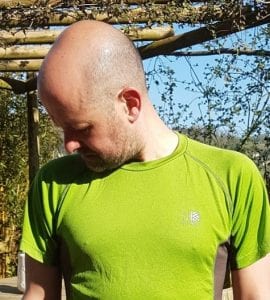
Stretch as above, but with your head carried diagonally downward (as if your looking to the outside of your foot). Perform this stretch both sides.
Door frame stretch
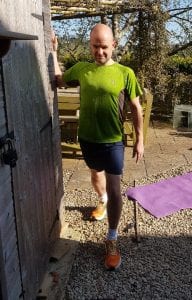
Technique:
Stand level with the doorframe and place your forearm flush to the frame at a 90 degree angle. With the leg furthest away from the frame, take a step forward and lunge gently.
Muscles being stretched:
Muscles at the front of the shoulder including pectorals, teres, anterior deltoid.
Additional information for performing this stretch correctly:
These muscles are notoriously tight in most people. Perform this stretch gently and slowly. Keep your hips facing forward (do not twist). Hold for a minimum of 20 seconds, maximum of 45
Bent arm shoulder stretch
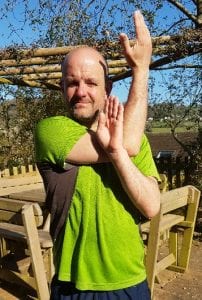
Technique:
Standing, place one arm across your body bent at 90 degrees. With your other arm also at 90 degrees, pull across your body.
Muscles being stretched:
Muscles at the back of the shoulder, and muscles of the back, including Trapezius, rhomboids, posterior deltoid, infraspinatus
Additional information for performing this stretch correctly:
Hold for a minimum of 20 seconds, maximum of 45
Reaching up shoulder stretch
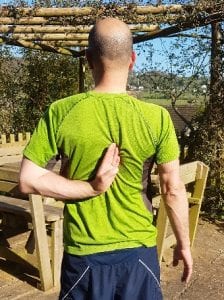
Technique:
Place one arm behind your back and reach up with the outer side of your hand between your shoulders
Muscles being stretched:
Muscles of the rotator cuff at the front and back of the shoulder including infraspinatus, pectorals, anterior deltoid and teres.
Additional information for performing this stretch correctly:
These muscles are notoriously tight in most people. Perform this stretch gently and slowly. Hold for a minimum of 20 seconds, maximum of 45
Search
Recent Articles
- The Good, The Bad and The Ugly of Coaching
- Does your horse need more energy, especially when competing?
- Grade 1 International Para Dressage Rider Di Green- Why Lexi Needed a Year Off
- Louise Blanch – Driving Towards New Horizons with the Continued Support of the Para Equestrian Foundation.
- Kissing Spine – Prevention or Cure?
Categories
- Advice Hub
- Athlete
- Carriage Driving
- Dentistry
- Dressage
- Endurance
- Eventing
- Farrier
- Featured
- Featured Horse Ads
- Featured Posts
- Horse Racing
- Horse's Mouth
- Horseball
- Hunting
- Le Trec
- Leisure Riders
- Mounted Games
- Nutrition
- Polo
- Polocrosse
- Reining
- Rescue & Rehabilitation
- Show Jumping
- Showing
- Tack Room
- Team Chasing
- The Pony Club
- Therapy
- Training
- Vaulting
- Veterinary




